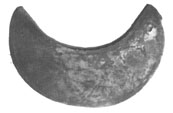
| Gorgets by Clayton C. Carroll (May 1991) in 19th Century Seminole Men`s Clothing
|

| Gorgets by Clayton C. Carroll (May 1991) in 19th Century Seminole Men`s Clothing
|
(Note: Clay Carroll does not describe a way to make museum quality early 19th century style gorgets. But, he has come up with an easy effective way to make late-19th century qorgets that would be appropriate for almost any reenactments or Scout ceremonies. -Ed.)
History:
The "Kona-wwata-ki", or crescent sliver gorgets, have an interesting origin (Sturtevant, 1967). English officers wore gorgets as a symbol of rank. In some cases, Indian chiefs were awarded an army rank for service given to the English in time of war. When a chief received a mliltary rank, he was given a standard army gorget (Goggin, 1940). As time passed, gorgets were copied by other male tribal members and worn as decoration. They heated silver coins and pounded them together with a hammer. Graduated gorgets were worn in sets of two or three, but there is an occasional picture showing four worn. (Fig. 7, Sturtevant, 1967; Fig. 62, MacCauley, 1887). When in graduated sizes, the largest was worn at the top, its upper curves usually Just touching at the collarbones. Earlier 1820's and 1830's gorgets seen in McKenney-Hall are much smaller than mid or late 19th century gorgets. Gorgets were made, however infrequently, up to the 1930's, and began to disappear after then (Sturtevant, 1967). Although here are patterns and instructions for gorget construction, I urge you to do your own research. These instructions are intended for hobbyists who want an acceptable reproduction of gorgets made in the late 1800's and early 1900's. |
Materials:
|
Each set of two gorgets will need a 6" by 12" sheet of 20 gauge German silver. Nickle silver is available from Indian hobbyist catalogs such as Crazy Crow Trading Post and Grey Owl. It is also occasionally available from lapidary shops. Or, you could be extravagant and buy sheets of real silver for $100-$125 each. A package of sllver upholstery tacks can be found at almost any hardware store or in house wares at a department store. They should be plain with no designs on the head of the tacks. A small leather thong 2-1/3 or 3 feet in length can be cut from almost any scrap of leather. |
 |
Clayton C. Carroll's Instructions for making Gorgets
Return to Seminole Silver Work
Introduction to Seminole Accessories
Complete Index to Articles in 19th Century Seminole Men's Clothing

|
Text and Graphics
© 1994 - Tara Prindle unless otherwise cited. |